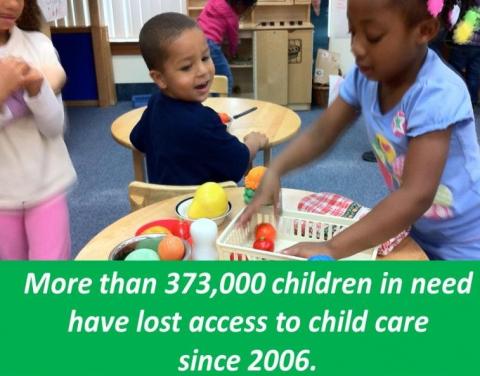
Number of children benefiting from federal low-income child care program at 17-year low
The number of children receiving child care funded by the Child Care and Development Block Grant (CCDBG) fell to a 17-year low, according to the Center for Law and Social Policy (CLASP). The CCDBG is the primary source of federal funding for helping low-income families pay for child care, with half of the families who receive benefits living below the poverty level.
In 2015, fewer than 1.4 million children received child care funded through the CCDBG in an average month, the smallest number of children served in the program since 1998. The 2015 number represents roughly 41,200 fewer children served than in 2014 and roughly 373,100 fewer children than in 2006. That’s a 21 percent drop in children served over nine years. CLASP’s analysis of data from the Department of Health and Human Services shows that in Tennessee, for example, 7,400 fewer children were served in 2015 than in 2014, and 17,000 fewer children were served compared to 2006. In fact, between 2006 and 2015, only seven states increased the number of children served; 18 states reduced their average monthly number of children served by more than 25 percent. See how kids in your state fared.
Sadly, this isn’t a new problem: I’ve written similar posts the last two years. This is, in fact, the 5th straight year of declining numbers. And each of those declines represents tens of thousands of children and families who were hurt by these cuts in spending.
According to HHS, only 15 percent of children – or roughly 1 out of every 7 kids – eligible to receive assistance was served in 2012; this includes children served through the Temporary Assistance for Needy Families (TANF) block grant. When CLASP looked at racial and ethnic differences in access to CCDBG, they found that just 13 percent of eligible children were served nationally, with only 8 percent of eligible Latino children and just 6 percent of American Indian and Alaskan Native children getting help.
The Coalition on Human Needs' report released last fall, The High Cost of Being Poor, found that a family at the poverty line with an infant and toddler in a child care center would have to spend 73 percent of its income on child care, if paying the national average cost. Without a subsidy, low-income families have no choice but to make cheaper and often less reliable arrangements. But ensuring low-income families have access to quality, affordable child care is critical. Child care subsidies are linked to improved employment outcomes for parents. And children need quality care that fosters early learning in a safe environment. The subsidies they receive allow families to use their limited resources on their many other expenses, such as food and rent. Without the help of CCDBG and TANF funds, children – and their family’s stability – could be at risk.
At the end of 2014, the CCDBG was reauthorized for the first time in almost 20 years. That was a good thing: many of the new provisions such as requiring background checks for staff, reporting of child abuse, training for child care workers, and health and safety inspections were long overdue. And states are working to implement the law. But the law did not come with a guarantee of federal funding to implement the changes. If more funds out of the limited child care pot have to be diverted to pay for these important improvements, even fewer children will receive affordable child care.
CLASP has estimated that an additional $1.2 billion investment is needed to fully implement the law and prevent additional children from losing access to child care. Just yesterday, however, the Trump Administration called for slashing non-defense domestic programs to pay for a $54 billion bump up in defense spending for Fiscal Year 2018. While we don’t yet know which human needs programs will be cut or by how much, it’s a good guess that his budget plan, once released, won’t include an additional $1.2 billion for child care and will instead include cuts to programs that are critical to low-income children and their families.
Stay tuned to the Coalition on Human Needs for more information on the President’s budget requests and how you can take action. Because when our children suffer, our nation does too.
This post was originally published on the Coalition on Human Needs' blog, Voices for Human Needs. Receive similar articles in your inbox by subscribing today, and follow CHN on Facebook and Twitter.



The views and opinions expressed in this post are those of the author(s) and do not necessarily reflect those of MomsRising.org.
MomsRising.org strongly encourages our readers to post comments in response to blog posts. We value diversity of opinions and perspectives. Our goals for this space are to be educational, thought-provoking, and respectful. So we actively moderate comments and we reserve the right to edit or remove comments that undermine these goals. Thanks!